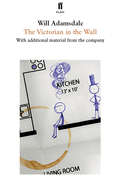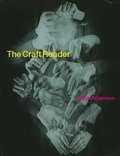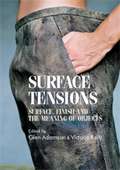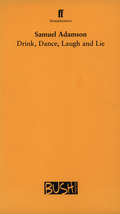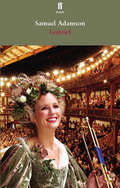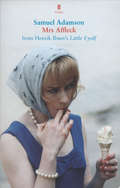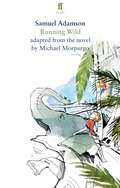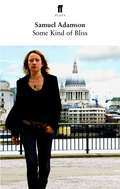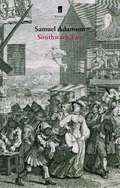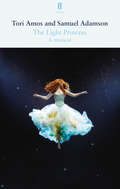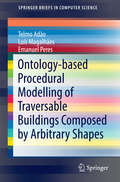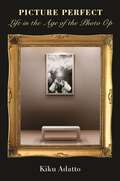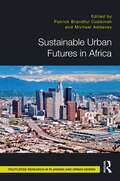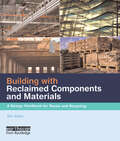- Table View
- List View
The Victorian in the Wall
by Will AdamsdaleLatte-land. Power-prams, Grand Design knock-throughs, organic everything. A work-shy writer discovers a Victorian man living in the wall of his flat. Everyone's pretty surprised. Adjustments need to be made. Can the strange visitor unlock his hopeless career? His flagging relationship? A story buried in these walls for over a century? (Doubt it. Maybe. Yes.) Contains jokes, songs, banging on recycling boxes, a talking fridge. Will Adamsdale's The Victorian in the Wall premiered at the Royal Court Theatre, London, in May 2013.
Craft: An American History (The\journal Of Modern Craft Ser. #No. 1)
by Glenn AdamsonA groundbreaking and endlessly surprising history of how artisans created America, from the nation's origins to the present day. At the center of the United States' economic and social development, according to conventional wisdom, are industry and technology-while craftspeople and handmade objects are relegated to a bygone past. Renowned historian Glenn Adamson turns that narrative on its head in this innovative account, revealing makers' central role in shaping America's identity. Examine any phase of the nation's struggle to define itself, and artisans are there-from the silversmith Paul Revere and the revolutionary carpenters and blacksmiths who hurled tea into Boston Harbor, to today's “maker movement.” From Mother Jones to Rosie the Riveter. From Betsy Ross to Rosa Parks. From suffrage banners to the AIDS Quilt. Adamson shows that craft has long been implicated in debates around equality, education, and class. Artisanship has often been a site of resistance for oppressed people, such as enslaved African-Americans whose skilled labor might confer hard-won agency under bondage, or the Native American makers who adapted traditional arts into statements of modernity. Theirs are among the array of memorable portraits of Americans both celebrated and unfamiliar in this richly peopled book. As Adamson argues, these artisans' stories speak to our collective striving toward a more perfect union. From the beginning, America had to be-and still remains to be-crafted.
The Craft Reader (PDF)
by Glenn AdamsonFrom the canonical texts of the Arts and Crafts Movement to the radical thinking of today's "DIY" movement, from theoretical writings on the position of craft in distinction to Art and Design to how-to texts from renowned practitioners, from feminist histories of textiles to descriptions of the innovation born of necessity in Soviet factories and African auto-repair shops...The Craft Reader presents the first comprehensive anthology of writings on modern craft. Covering the period from the Industrial Revolution to today, the Reader draws on craft practice and theory from America, Europe, Asia and Africa. The world of craft is considered in its full breadth -- from pottery and weaving, to couture and chocolate-making, to contemporary art, architecture and curation. The writings are themed into sections and all extracts are individually introduced, placing each in its historical, cultural and artistic context. Bringing together an astonishing range of both classic and contemporary texts, The Craft Reader will be invaluable to any student or practitioner of Craft and also to readers in Art and Design. AUTHORS INCLUDE: Theodor Adorno, Anni Albers, Amadou Hâmpaté Bâ, Charles Babbage, Roland Barthes, Andrea Branzi, Alison Britton, Rafael Cardoso, Johanna Drucker, Charles Eames, Salvatore Ferragamo, Kenneth Frampton, Alfred Gell, Walter Gropius, Tanya Harrod, Martin Heidegger, Patrick Heron, Bernard Leach, Esther Leslie, W. R. Lethaby, Lucy Lippard, Adolf Loos, Karl Marx, William Morris, Robert Morris, László Moholy-Nagy, Stefan Muthesius, George Nakashima, Octavio Paz, Grayson Perry, M. C. Richards, John Ruskin, Raphael Samuel, Ellen Gates Starr, Debbie Stoller, Alexis de Tocqueville, Lee Ufan, Frank Lloyd Wright.
Fewer, Better Things: The Hidden Wisdom of Objects
by Glenn AdamsonFrom the former director of the Museum of Arts and Design in New York, a timely and passionate case for the role of the well-designed object in the digital age. Curator and scholar Glenn Adamson opens Fewer, Better Things by contrasting his beloved childhood teddy bear to the smartphones and digital tablets children have today. He laments that many children and adults are losing touch with the material objects that have nurtured human development for thousands of years. The objects are still here, but we seem to care less and know less about them. In his presentations to groups, he often asks an audience member what he or she knows about the chair the person is sitting in. Few people know much more than whether it's made of wood, plastic, or metal. If we know little about how things are made, it's hard to remain connected to the world around us. Fewer, Better Things explores the history of craft in its many forms, explaining how raw materials, tools, design, and technique come together to produce beauty and utility in handmade or manufactured items. Whether describing the implements used in a traditional Japanese tea ceremony, the use of woodworking tools, or the use of new fabrication technologies, Adamson writes expertly and lovingly about the aesthetics of objects, and the care and attention that goes into producing them. Reading this wise and elegant book is a truly transformative experience.
The Invention Of Craft (PDF)
by Glenn AdamsonGlenn Adamson's last book, Thinking Through Craft, offered an influential account of craft's position within modern and contemporary art. Now, in his engaging sequel, The Invention of Craft, his theoretical discussion of skilled work is extended back in time and across numerous disciplines. Adamson searches out the origins of modern craft, locating its emergence in the period of the industrial revolution. He demonstrates how craft was invented as industry's 'other', a necessary counterpart to ideas of progress and upheaval. In the process, the magical and secretive culture of artisans was gradually dominated through division and explication. This left craft with an oppositional stance, a traditional or anti-modern position. The Invention of Craft ranges widely across media, from lock-making, wood-carving and iron-casting to fashion, architecture and design. It also moves back and forth between periods, from the 18th century to the present day, demonstrating how contemporary practice can be informed through the study of modern craft in its moment of invention.
Surface Tensions: Surface, Finish and the Meaning of Objects (PDF)
by Glenn Adamson Victoria KelleySurfaces are often held to be of lesser consequence than ‘deeper’ or more ‘substantive’ aspects of artworks and objects. Yet it is also possible to conceive of the surface in more positive terms: as a site where complex forces meet. Surfaces can be theorized as membranes, protective shells, sensitive skins, even thicknesses in their own right. The surface is not so much a barrier to content as an opportunity for encounter: in new objects, the surface is the site of qualities of finish, texture, the site of tactile interaction, the last point of contact between object and maker, and the first point of contact between object and user. Surface tensions includes sixteen essays that explore this theoretically uncharted terrain. The subjects range widely: domestic maintenance; avant-garde fashion; the faking of antiques; postmodern architecture and design; contemporary film costume. Of particular emphasis within the volume are textiles, which are among the most complex and culturally rich materialisations of surface. As a whole, the book provides insights into the whole lifecycle of objects, not just their condition when new.
Global Design History
by Glenn Adamson Giorgio Riello Sarah TeasleyGlobalism is often discussed using abstract terms, such as ‘networks’ or ‘flows’ and usually in relation to recent history. Global Design History moves us past this limited view of globalism, broadening our sense of this key term in history and theory. Individual chapters focus our attention on objects, and the stories they can tell us about cultural interactions on a global scale. They place these concrete things into contexts, such as trade, empire, mediation, and various forms of design practice. Among the varied topics included are: the global underpinnings of Renaissance material culture the trade of Indian cottons in the eighteenth-century the Japanese tea ceremony as a case of ‘import substitution’ German design in the context of empire handcrafted modernist furniture in Turkey Australian fashions employing ‘ethnic’ motifs an experimental UK-Ghanaian design partnership Chinese social networking websites the international circulation of contemporary architects. Featuring work from leading design historians, each chapter is paired with a ‘response’, designed to expand the discussion and test the methodologies on offer. An extensive bibliography and resource guide will also aid further research, providing students with a user friendly model for approaches to global design. Global Design History will be useful for upper-level undergraduate and postgraduate students, academics and researchers in design history and art history, and related subjects such as anthropology, craft studies and cultural geography.
Global Design History
by Glenn Adamson Giorgio Riello Sarah TeasleyGlobalism is often discussed using abstract terms, such as ‘networks’ or ‘flows’ and usually in relation to recent history. Global Design History moves us past this limited view of globalism, broadening our sense of this key term in history and theory. Individual chapters focus our attention on objects, and the stories they can tell us about cultural interactions on a global scale. They place these concrete things into contexts, such as trade, empire, mediation, and various forms of design practice. Among the varied topics included are: the global underpinnings of Renaissance material culture the trade of Indian cottons in the eighteenth-century the Japanese tea ceremony as a case of ‘import substitution’ German design in the context of empire handcrafted modernist furniture in Turkey Australian fashions employing ‘ethnic’ motifs an experimental UK-Ghanaian design partnership Chinese social networking websites the international circulation of contemporary architects. Featuring work from leading design historians, each chapter is paired with a ‘response’, designed to expand the discussion and test the methodologies on offer. An extensive bibliography and resource guide will also aid further research, providing students with a user friendly model for approaches to global design. Global Design History will be useful for upper-level undergraduate and postgraduate students, academics and researchers in design history and art history, and related subjects such as anthropology, craft studies and cultural geography.
Global Design History
by Glenn Adamson Giorgio Riello Sarah TeasleyGlobalism is often discussed using abstract terms, such as ‘networks’ or ‘flows’ and usually in relation to recent history. Global Design History moves us past this limited view of globalism, broadening our sense of this key term in history and theory. Individual chapters focus our attention on objects, and the stories they can tell us about cultural interactions on a global scale. They place these concrete things into contexts, such as trade, empire, mediation, and various forms of design practice. Among the varied topics included are: the global underpinnings of Renaissance material culture the trade of Indian cottons in the eighteenth-century the Japanese tea ceremony as a case of ‘import substitution’ German design in the context of empire handcrafted modernist furniture in Turkey Australian fashions employing ‘ethnic’ motifs an experimental UK-Ghanaian design partnership Chinese social networking websites the international circulation of contemporary architects. Featuring work from leading design historians, each chapter is paired with a ‘response’, designed to expand the discussion and test the methodologies on offer. An extensive bibliography and resource guide will also aid further research, providing students with a user friendly model for approaches to global design. Global Design History will be useful for upper-level undergraduate and postgraduate students, academics and researchers in design history and art history, and related subjects such as anthropology, craft studies and cultural geography.
Global Design History (PDF)
by Glenn Adamson Giorgio Riello Sarah TeasleyGlobalism is often discussed using abstract terms, such as ‘networks’ or ‘flows’ and usually in relation to recent history. Global Design History moves us past this limited view of globalism, broadening our sense of this key term in history and theory. Individual chapters focus our attention on objects, and the stories they can tell us about cultural interactions on a global scale. They place these concrete things into contexts, such as trade, empire, mediation, and various forms of design practice. Among the varied topics included are: the global underpinnings of Renaissance material culture the trade of Indian cottons in the eighteenth-century the Japanese tea ceremony as a case of ‘import substitution’ German design in the context of empire handcrafted modernist furniture in Turkey Australian fashions employing ‘ethnic’ motifs an experimental UK-Ghanaian design partnership Chinese social networking websites the international circulation of contemporary architects. Featuring work from leading design historians, each chapter is paired with a ‘response’, designed to expand the discussion and test the methodologies on offer. An extensive bibliography and resource guide will also aid further research, providing students with a user friendly model for approaches to global design. Global Design History will be useful for upper-level undergraduate and postgraduate students, academics and researchers in design history and art history, and related subjects such as anthropology, craft studies and cultural geography.
Drink, Dance, Laugh and Lie
by Samuel AdamsonNo one has recognised Reade Collins in the street for over a decade. Suddenly everyone seems to know who he is again - things are looking up. But there's a flip side to second-hand fame - and Reade discovers that there's more than one way of getting shafted. Drink, Dance, Laugh and Lie is a wildly entertaining look at the nature of celebrity.Drink, Dance, Laugh and Lie premiered at the Bush Theatre, London, in 1999.
Gabriel
by Samuel AdamsonThis is noisily Protestant England - the England of William and Mary's Glorious Revolution at the end of a century of civil strife. This is London in the 1690s, the monster city tamed into awe by our only Orpheus: Henry Purcell.Monarchs, princes, prostitutes, wigmakers, composers, tapsters, musicians, transvestites and watermen jostle for attention in the teeming, unruly world of late seventeenth-century London, where enthralling stories both real and imagined merge and intersect.Samuel Adamson's Gabriel premiered at Shakespeare's Globe, London, in July 2013 with Alison Balsom, one of the world's finest trumpeters, performing the music of Purcell and Handel. Every day three trumpet calls from the theatres on the Bankside, then songs would float over the thatch and roll across the water and make my work sweet.
Mrs Affleck: from Ibsen's Little Eyolf
by Samuel AdamsonI know. No country matters. Not in the kitchen.Not on a Sunday. Not in England.After six lonely weeks with nobody but her disabled boy for company, Rita Affleck, wealthy, beautiful and consumed by jealous love, welcomes home her husband Alfred. But, far from the passionate reunion she so craves, there is only torment as Alfred's possessive half-sister arrives, and he announces his great revelation.I want things how they were ... My perfect poet ... 1945, one afternoon in London - on the floor,every last undiluted drop of you.Taking Ibsen's Little Eyolf as the inspiration for a passionate and tragic tale of obsessive love, set in 1950s England, Samuel Adamson's Mrs Affleck opened at the National Theatre, London, in January 2009.
Running Wild: Based on the Novel (Collector's Edition Ser.)
by Samuel AdamsonFor Lilly and her mother, going to Indonesia isn't just another holiday. It's an escape and a new start. But when Will takes a gentle ride along the beach on an elephant called Oona, calamity strikes. As a tsunami comes crashing towards them, Oona charges deep into the jungle, her young rider desperately clinging on. Miles from civilisation, there's wonder, discovery and treetop adventures among the orang-utans. But then as Lilly's thoughts turn to his mother left behind on the beach, tigers prowl, hunger hits, and she must learn to survive the rainforest.Samuel Adamson's adaptation of Michael Morpurgo's novel Running Wild was premiered by the Chichester Festival Youth Theatre in 2015. It received its professional premiere in May 2016, in a Regent's Park Theatre and Chichester Festival Theatre co-production.Running Wild was winner of Best Show for Children and Young People at the 2015 UK Theatre Awards.
Some Kind of Bliss
by Samuel AdamsonToday - after I had the electric sex, got clobbered, killed the dog and parked the hijacked ice-cream van - I found the pop legend's house in Greenwich.Small-time hack and seeker of minor adventure, Rachel sets off down the Thames Path to Greenwich to interview Lulu for her tabloid's glossy supplement. But between London Bridge and the pop legend's mirrored hallway lies a series of unpredicted and comic events. Some Kind of Bliss is a play about how a walk on an everyday Wednesday can become an odyssey that turns your life upside down. Some Kind of Bliss opened at the Trafalgar Studios, London, in November 2007.
Southwark Fair
by Samuel AdamsonSimon is looking forward to lunch with Patrick Mulligan, the first man he slept with nearly twenty years previously, while playing Puck in a school production. It soon becomes apparent that Patrick is expecting to see not Simon, but the boy who played Lysander, and their lunch is cut short. When Simon is approached by Patrick's wife the situation becomes increasingly tortured and darkly comic.Southwark Fair premiered at the National Theatre, London, in February 2006.
The Light Princess
by Samuel Adamson Tori AmosI'm done, Father,Keep your crown,I swear you'll never bring me down!I am not queen material!Once, in opposing kingdoms lived a princess and a prince who had lost their mothers. Althea, unable to cry, became light with grief and floated, and so was locked away. Digby, so heavy-hearted that he could never smile, one day declares war. Althea, forced out of hiding, escapes, only to encounter the solemn prince on contested land and the warring heirs begin a passionate affair. But for Althea to find real love, she must first face her own deepest fears.
Ontology-based Procedural Modelling of Traversable Buildings Composed by Arbitrary Shapes (SpringerBriefs in Computer Science)
by Telmo Adão Luís Magalhães Emanuel PeresThis book presents a new procedural modelling methodology capable of producing traversable buildings constrained by arbitrary convex shapes, based on a pure treemap approach. The authors establish a process to change the format of interior rooms, through wall number modification and offer an adaptation of a “fake-concave” technique to support non-convex building layouts. It will also include: • A proposal for an extensible building ontology to guide the methodology process and support the generation of other architectural style buildings (e.g. roman houses); • A presentation of an ontology-based grammar to provide the procedural modelling methodology with production rules; • Experimental computer managed processes for the stochastic generation of buildings.Most of the existing solutions regarding building interiors only focus on the generation of floor plans mainly composed of rectangular shapes. Yet there are a wide variety of ancient and contemporary buildings that are composed of shapes other than rectangles, both internally and externally. Ontology-based Procedural Modelling of Traversable Buildings Composed by Arbitrary Shapes will address this by providing the Procedural Modelling field with processes and techniques capable of properly supporting for example, digital preservation of cultural heritage or extensive virtual urban environment productions, specifically ones involving the generation/reconstruction of virtual buildings with such geometric requirements.
Picture Perfect: Life in the Age of the Photo Op
by Kiku AdattoWe say the camera doesn't lie, but we also know that pictures distort and deceive. In Picture Perfect, Kiku Adatto brilliantly examines the use and abuse of images today. Ranging from family albums to Facebook, political campaigns to popular movies, images of war to pictures of protest. Adatto reveals how the line between the person and the pose, the real and the fake, news and entertainment is increasingly blurred. New technologies make it easier than ever to capture, manipulate, and spread images. But even in the age of the Internet, we still seek authentic pictures and believe in the camera's promise to document, witness, and interpret our lives.
Picture Perfect: Life in the Age of the Photo Op - New Edition
by Kiku AdattoWe say the camera doesn't lie, but we also know that pictures distort and deceive. In Picture Perfect, Kiku Adatto brilliantly examines the use and abuse of images today. Ranging from family albums to Facebook, political campaigns to popular movies, images of war to pictures of protest. Adatto reveals how the line between the person and the pose, the real and the fake, news and entertainment is increasingly blurred. New technologies make it easier than ever to capture, manipulate, and spread images. But even in the age of the Internet, we still seek authentic pictures and believe in the camera's promise to document, witness, and interpret our lives.
Picture Perfect: Life in the Age of the Photo Op - New Edition
by Kiku AdattoWe say the camera doesn't lie, but we also know that pictures distort and deceive. In Picture Perfect, Kiku Adatto brilliantly examines the use and abuse of images today. Ranging from family albums to Facebook, political campaigns to popular movies, images of war to pictures of protest. Adatto reveals how the line between the person and the pose, the real and the fake, news and entertainment is increasingly blurred. New technologies make it easier than ever to capture, manipulate, and spread images. But even in the age of the Internet, we still seek authentic pictures and believe in the camera's promise to document, witness, and interpret our lives.
Sustainable Urban Futures in Africa
by Michael Addaney Patrick CobbinahSustainable Urban Futures in Africa provides a variety of conventional and emerging theoretical frameworks to inform understandings and responses to critical urban development issues such as urbanisation, climate change, housing/slum, informality, urban sprawl, urban ecosystem services and urban poverty, among others, within the context of the sustainable development goals (SDGs) in Africa. This book addresses topics including challenges to spatial urban development, how spatial planning is delivered, how different urbanisation variables influence the development of different forms of urban systems and settlements in Africa, how city authorities could use old and new methods of land administration to produce sustainable urban spaces in Africa, and the role of local activism is causing important changes in the built environment. Chapters are written by a diverse range of African scholars and practitioners in urban planning and policy design, environmental science and policy, sociology, agriculture, natural resources management, environmental law, and politics. Urban Africa has huge resource potential – both human and natural resources – that can stimulate sustainable development when effectively harnessed. Sustainable Urban Futures in Africa provides support for the SDGs in urban Africa and will be of interest to students and researchers, professionals and policymakers, and readers of urban studies, spatial planning, geography, governance, and other social sciences.
Smart Materials and Technologies in Architecture
by Michelle Addington Daniel SchodekToday, architects and designers are beginning to look toward developments in new"smart" or "intelligent" materials and technologies for solutions to long-standing problemsin building design. However, these new materials have so far been applied in a diversebut largely idiosyncratic nature, because relatively few architects have access toinformation about the types or properties of these new materials or technologies.Two of the leading experts in this field - Addington and Schodek - have solved thisproblem by incorporating all the relevant information of all the latest technologiesavailable to architects and designers in this one volume. They present materials bydescribing their fundamental characteristics, and go on to identify and suggest howthese same characteristics can be exploited by professionals to achieve their designgoals. Here, the wealth of technical understanding already available in the materialsscience and engineering literature is at last made accessible to a design audience.
Smart Materials and Technologies in Architecture: For The Architecture And Design Professions
by Michelle Addington Daniel SchodekToday, architects and designers are beginning to look toward developments in new"smart" or "intelligent" materials and technologies for solutions to long-standing problemsin building design. However, these new materials have so far been applied in a diversebut largely idiosyncratic nature, because relatively few architects have access toinformation about the types or properties of these new materials or technologies.Two of the leading experts in this field - Addington and Schodek - have solved thisproblem by incorporating all the relevant information of all the latest technologiesavailable to architects and designers in this one volume. They present materials bydescribing their fundamental characteristics, and go on to identify and suggest howthese same characteristics can be exploited by professionals to achieve their designgoals. Here, the wealth of technical understanding already available in the materialsscience and engineering literature is at last made accessible to a design audience.
Building with Reclaimed Components and Materials: A Design Handbook for Reuse and Recycling
by Bill AddisInterest in green and sustainable design is growing throughout the world. Both national and local governments are active in promoting reuse and recycling in order to reduce the amount of waste going to landfill. This guide identifies how building designers and constructors can minimize the generation of waste at the design stage of a building project by using reclaimed components and materials. Authoritative, accessible and much-needed, this book highlights the opportunities for using reclaimed components and materials and recycled-content building products for each element of a building, from structure and foundations to building services and external works. Current experience is illustrated with international case studies and practical advice. It discusses different approaches to designing with recycling in mind, and identifies the key issues to address when specifying reclaimed components and recycled materials in construction work. This book will be invaluable for building professionals � including architects, specifiers, structural and service engineers, quantity surveyors, contractors and facilities managers � as well as students of architecture and civil engineering. Published with NEF
